Act of Union
The Act of Union was passed by the British Parliament in July 1840 and proclaimed 10 February 1841. It united the colonies of Upper Canada and Lower Canada under one government, creating the Province of Canada.

-
May 12, 1785
Act of Union
"Negro Frolicks" Prohibited
Officials in Nova Scotia ordered "50 Handbills [to] be immediately printed forbidding Negro Dances & Negro Frolicks in [the] town of Shelburne."
-
June 08, 1826
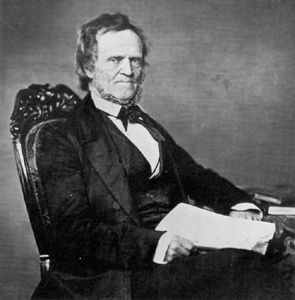
Act of Union
Mackenzie's Office Raided
Members of the Family Compact raided the offices of William Lyon Mackenzie's newspaper, the Colonial Advocate, at York.
-
May 21, 1832
Act of Union
Rioting in Montreal
Rioting erupted during a by-election in Montreal when the Patriote candidate began to take the lead. British soldiers fired on the crowd, killing 3.
-
June 24, 1834
Act of Union
St-Jean-Baptiste Society
The St-Jean-Baptiste Society was founded by journalist Ludger Duvernay, who wanted to stimulate a nationalist spirit among his compatriots and encourage them to defend their linguistic and cultural heritage.
-
September 05, 1837
Act of Union
Fils de la Liberté (Sons of Liberty)
The Fils de la Liberté, a party formed by 700-800 Patriotes, held their first public assembly. Inspired by the ideals of the American Revolution, the Fils believed in the right of the people to choose their own government and of a colony to become independent.
-
October 23, 1837
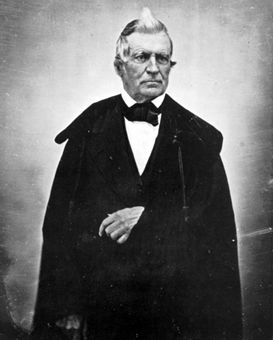
Act of Union
Papineau Addresses Rally
Louis-Joseph Papineau spoke to some 4000 at Saint-Charles at which the Patriotes more or less declared the independence of the Six Counties and their willingness to resort to arms if necessary.
-
November 06, 1837
Act of Union
Street Fight in Montreal
Thomas Brown led the Fils de la Liberté in a street fight with members of the English-Canadian Doric Club in Montréal, a prelude to the Rebellions.
-
November 16, 1837
Act of Union
Patriotes Start Rebellion
A Patriote force attacked the newly formed Montreal Volunteer Cavalry near Longueuil and started the rebellion in Lower Canada.
-
November 16, 1837
Act of Union
Insurrection in Lower Canada
Governor Gosford issued warrants for the arrest of 26 Patriote leaders on charges of high treason, initiating the events of the Lower Canada Rebellion. Troops and Patriotes were in battle a few days later.
-
November 23, 1837

Act of Union
Battle of Saint-Denis
General Charles Gore and government forces suffered a minor defeat by Patriote forces at Saint-Denis.
-
November 25, 1837
Act of Union
Patriotes Crushed
The Patriotes were crushed by government forces at St-Charles with 56 dead; Papineau fled to the US.
-
December 05, 1837

Act of Union
Rebellion in Upper Canada
William Lyon Mackenzie led a rag-tag contingent of 800 men down Yonge Street toward Toronto. Government loyalists dispersed the rebels with a few shots, ending Mackenzie's erratic attempt to overthrow the colonial government.
-
December 07, 1837
Act of Union
John A. Macdonald and the Rebellion of 1837
John A. Macdonald's early professional career coincided with the rebellion in Upper Canada and subsequent border raids from the US. He was in Toronto in December 1837 where, as a militia private, he took part in the attack on the rebels at Montgomery's Tavern. In 1838, he attracted public notice by defending accused rebels, including Nils von Schoultz, leader of an attack on Prescott.
-
December 11, 1837
Act of Union
Corps of Negroes
In the early 19th century, few Upper Canada militia units included Blacks. When the Mackenzie Rebellion broke out, the government welcomed Black men into the provincial forces. On 11 December 1837, a militia order authorized Captains Thomas Runchey and James Sears to raise a "corps of Negroes." Four days later, approximately 50 Blacks had joined the corps.
-
December 14, 1837

Act of Union
Battle of St-Eustache
Sir John Colborne captured St-Eustache after fierce resistance by the Patriotes during the Lower Canada Rebellion.
-
December 14, 1837
Act of Union
Chenier Killed
Patriote leader Jean-Olivier Chénier was killed in combat at St-Eustache.
-
January 05, 1838
Act of Union
Hunter's Lodges
A US proclamation forbade Americans from joining in the fighting in the Upper and Lower Canada Rebellions. Some American sympathizers organized in secret societies, called Hunters' Lodges, to take part in cross-border attacks in support of the rebellions.
-
January 08, 1838
Act of Union
Attack at Amherstburg
A Patriote attack against Amherstburg, Upper Canada (Ontario), was defeated by Canadian militiamen.
-
February 10, 1838
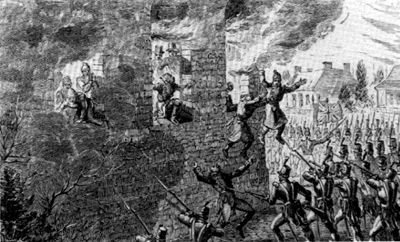
Act of Union
Constitution Suspended
The Constitution of 1791 was suspended in Lower Canada following the 1837 Rebellion. An "authoritarian" political body, the Special Council, was appointed in its stead. The second Rebellion in Lower Canada soon followed.
-
February 26, 1838
Act of Union
Frères Chasseurs Attempt Invasion of Lower Canada
Rebel and Papineau supporter Robert Nelson gathered between 600 and 700 volunteers, the Société des frères Chasseurs (Hunters' Lodges), in an attempt to invade Lower Canada. Hunters' Lodges were the largest of the Secret Societies pledged to liberate the Canadian provinces from British thralldom.
-
March 06, 1838
Act of Union
Blacks in Upper Canada Publicly Praised
In the spring of 1838, Lieutenant-Governor Sir Francis Bond Head addressed the legislature to publicly praise Black Upper Canadians for their loyalty and service during the recent rebellions.
-
March 30, 1838

Act of Union
Durham Appointed
The Earl of Durham was appointed governor-in-chief of British North America and commissioner to investigate the causes of the rebellions. He served from May 29 to November 1.
-
April 12, 1838
Act of Union
Lount and Matthews Hanged
Samuel Lount and Peter Matthews were hanged for treason, at Toronto, for their roles in the Rebellion of 1837.
-
July 04, 1838
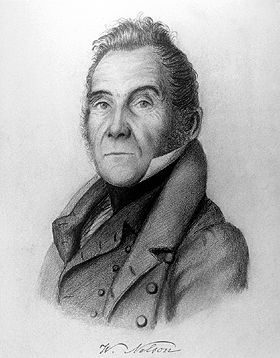
Act of Union
Nelson Deported
Former House of Assembly member Wolfred Nelson was deported to Bermuda, along with 8 other Patriotes, following the Lower Canada Rebellion.
-
November 04, 1838
Act of Union
Second Rebellion in Lower Canada
Robert Nelson and Cyrille Côté led a 2nd rebellion in Lower Canada. Côté's men fled after a skirmish at Lacolle; Nelson retreated to Odelltown, north of the Vermont border, where he was defeated by Charles Taylor on November 9.
-
November 09, 1838
Act of Union
Battle of Odelltown
The Patriotes were defeated at the Battle of Odelltown. It was one of the last skirmishes of the Lower Canada Rebellion.
-
November 12, 1838
Act of Union
Battle of the Windmill
Colonel Nils Von Schoultz ran the schooner Charlotte aground some miles below Prescott, and took up a position in a windmill and several stone houses nearby. Canadian militia pounded the windmill and resistance collapsed on November 16.
-
January 18, 1839

Act of Union
Rebels Hanged
Rebels were hanged at Montréal for their part in the Rebellions of 1837.
-
February 15, 1839
Act of Union
Patriote Rebels Hanged
Five Patriotes, followers of Louis-Joseph Papineau, were hung at the Pied-du-Courant Prison following a trial for treason and murder.
-
September 27, 1839
Act of Union
Patriotes Banished to Australia
The transport ship Buffalo left Lower Canada carrying 58 Patriotes bound for Australia. The Patriotes were exiled for their involvement in the Lower Canada Rebellion of 1837–38. The rebels were imprisoned at Longbottom Stockade in Sydney, spending their time breaking rocks and collecting oyster shells to make lime. By 1844, all had received pardons. Most returned to Canada.
-
July 23, 1840
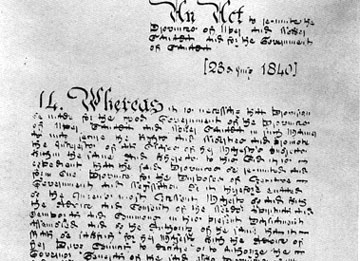
Act of Union
Act of Union Assent
The Act of Union joining Upper and Lower Canada received royal assent in England. It came into effect on 10 February 1841.
-
February 10, 1841

Act of Union
Act of Union in Effect
The Act of Union came into effect, uniting Upper and Lower Canada into the Province of Canada, a legislative union with 84 members divided equally between Canada East and Canada West.
-
February 13, 1841

Act of Union
Kingston Chosen Capital
Kingston, Canada West, was chosen capital of the United Canadas. It only remained the capital until 1843.
-
June 14, 1841
Act of Union
First Parliament in Canadas
The first session of the first Parliament of the United Canadas opened at Kingston, Canada West.
-
September 16, 1842
Act of Union
La Fontaine-Baldwin Cabinet
The first La Fontaine-Baldwin cabinet was formed in the Province of Canada. The partnership led to the development of responsible government across the country.
-
May 10, 1844

Act of Union
Capital Moves to Montreal
The capital of Canada was moved from Kingston to Montréal, Canada East.
-
May 26, 1846

Act of Union
Responsible Government in Newfoundland
Public meetings at St John's, Newfoundland, adopted resolutions in favour of responsible government.
-
February 02, 1848
Act of Union
Responsible Government in Nova Scotia
James Boyle Uniake became leader of a new Reform government. Nova Scotia was thus the first colony in the British Empire in which responsible government was in effect. Responsible government meant that a colony enjoyed complete self-government in domestic affairs and that a government ruled only with the support of the majority of the elected Assembly (the origins of today's cabinet government).
-
April 25, 1849

Act of Union
Rebellion Losses Bill
Lord Elgin gave assent to the Rebellion Losses Bill, in effect the first acceptance of the principle of responsible government, over violent Tory opposition. A Tory-inspired mob burned the Parliament buildings that day.
-
April 25, 1849

Act of Union
Parliament Buildings Burned
The Parliament Buildings in Montréal were burned down in riots protesting Lord Elgin's signing of the Rebellion Losses Bill. The seat of government was removed from Montréal and the Parliament met alternatively in Toronto and Québec City.
-
April 25, 1851
Act of Union
PEI Gets Responsible Government
PEI obtained responsible government, with George Coles as premier.
-
December 31, 1857

Act of Union
Ottawa Chosen Capital
Queen Victoria announced that she had chosen Ottawa to be the new capital of Canada. It became official on September 24, 1859.


